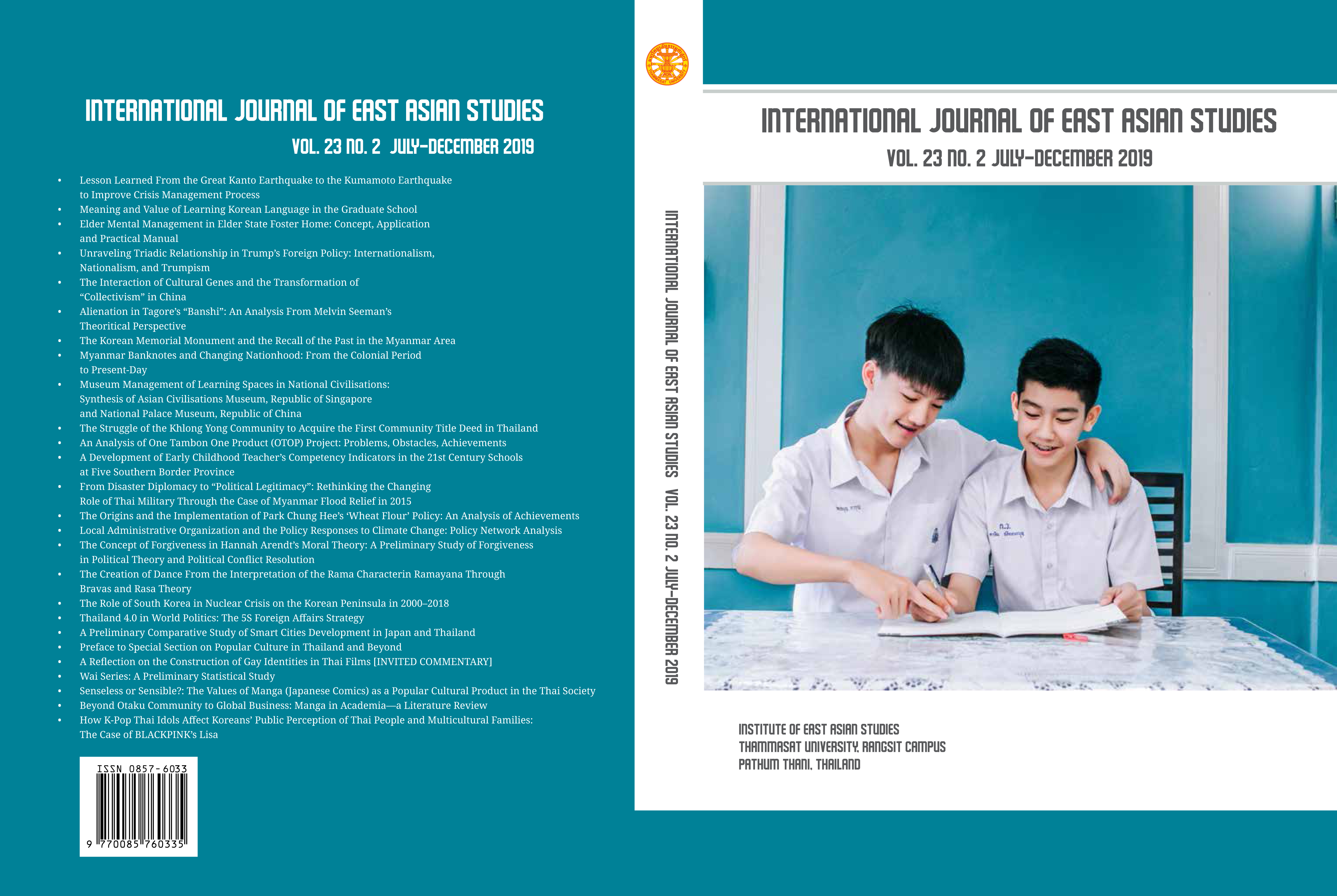Thailand 4.0 in World Politics: The 5S Foreign Affairs Strategy
Keywords:
Thailand 4.0, 5S strategy, 5S foreign affairs strategy, Thai foreign policy, ThailandAbstract
This article examines how the Thai government, led by General Prayut Chan-o-cha, conducted the nation’s foreign policy as part of a wider policy orientation and its vision of Thailand 4.0. It found that the Prayut government outlined its foreign policy strategy, called “5S foreign affairs strategy,” comprising: security, sustainability, standard, status, and synergy. Its 5S strategy echoed the Thai foreign policy tradition, widely recognized for its flexibility in a wind of change. Despite the list of diplomatic failures during the government’s first year in office, the government’s foreign-policy maneuvering in world politics could manage the external environment to be more favorable for Thailand’s economic development.
Downloads
References
Bunyavejchewin, P. (2017b). Thailand’s china policy: Thailand, china, and the mekong-lancang cooperation. Paper presented at the 11th Asian Political and International Studies Association (APISA) Annual Congress, Phitsanulok.
Bunyavejchewin, P. (2018a). Rai-ngan phon kan wichai chabap sombun thai kap kan kotang khwamruammue lan chang - mae khong [thailand and the formation of the lancang-mekong cooperation]. Institute of East Asian Studies, Thammasat University, Pathum Thani.
Bunyavejchewin, P. (2018b). Thai kap kan kotang khwamruammue echia [thailand and the formation of acd]. Journal of Social Sciences Naresuan University, 14(2), 1-24. doi:10.14456/jssnu.2018.11
Bunyavejchewin, P., & KridsanaChotisut. (2019). Nayobai tangprathet saharat-amerika samai prathanathibodi donan sam : Khwam tonueang khwam plianplaeng lae nai to sathianraphap nai echia tawan-ok [american foreign policy under president donald trump: Continuities, changes and implications for east asian stability]. International Journal of East Asian Studies, 23(1), 256-284.
Bunyavejchewin, P., & Nimmannorrawong, P. (2016). The asia cooperation dialogue (acd): Formation and development. Ritsumeikan Journal of Asia Pacific Studies, 35, 17-26.
Busbarat, P. (2016). “Bamboo swirling in the wind”: Thailand’s foreign policy imbalance between china and the united states. Contemporary Southeast Asia: A Journal of International and Strategic Affairs, 38(2), 233-257. doi:10.1355/cs38-2c
Busbarat, P. (2017). Shopping diplomacy: The thai prime minister’s visit to the united states and its implications for thai-us relations. ISEAS Perspective, (2017/78). Retrieved from ISEAS-Yusof Ishak Institute website: https://www.iseas.edu.sg/images/pdf/ISEAS_Perspective_2017_78.pdf
Chachavalpongpun, P. (2010). Reinventing thailand: Thaksin and his foreign policy. Singapore: Institute of Southeast Asian Studies.
Cogan, M. (2019). Is thailand accommodating china? Southeast Asian Social Science Review, 4(2), 24-47.
Crispin, S. W. (2016, June 10). Thailand’s post-coup foreign policy: Omnidirectional or directionless? The Diplomat. Retrieved from https://thediplomat.com/2016/06/thailands-post-coup-foreign-policy-omnidirectional-or-directionless/
Domínguez, G. (2015, February 8). Why thailand is boosting ties with russia and china. Deutsche Welle. Retrieved from https://www.dw.com/en/why-thailand-is-boosting-ties-with-russia-and-china/a-18367018
Fangye, Z. (2015, December 1). Thailand tilts toward china to ease us pressure. Global Times. Retrieved from http://www.globaltimes.cn/content/956016.shtml
Fernquest, J. (2017, May 2). Trump-prayut phone call: Closer ties begin. Bangkok Post. Retrieved from https://www.bangkokpost.com/learning/advanced/1242361/trump-prayut-phone-call-closer-ties-begin
Funston, J. (1987). The role of the ministry of foreign affairs in thailand: Some preliminary observations. Contemporary Southeast Asia, 9(3), 229-243.
Kongkirati, P., & Kanchoochat, V. (2018). The prayuth regime: Embedded military and hierarchical capitalism in thailand. TRaNS: Trans -Regional and -National Studies of Southeast Asia, 6(2), 279-305. doi:10.1017/trn.2018.4
MFA. (1989, November 2). Ekkasan prakopkan banyai rueang krasuang kantangprathet doi nai won phot sanit wong na a yut ya. [declassified document]. MFA Archives and Library Division, Bangkok.
MFA. (2014). Announcement of the national council for peace and order (ncpo) no. 34/2557 [Press release]. Retrieved from http://mfa.go.th/main/en/media-center/3756/46195-Announcement-of-the-National-Peace-and-Order-Maint.html
MFA. (2019a). Roi rueang lao ton kan thut 5 mi. Bangkok: MFA.
MFA. (2019b). Thailand's foreign affairs achievements in the past four years [Press release]. Retrieved from http://www.thaiembassy.org/wellington/contents/files/news-20190220-055222-358179.pdf
Phuangkasem, C. (1984). Thailand's foreign relations, 1964-80. (ISEAS Occasional Paper No. 74). Institute of Southeast Asian Studies, Singapore.
Phuangkasem, C. (1999) Thailand's foreign policies: The four decades after the second world war (1945-1989). MIR Occasional Paper Series. MIR Occasional Paper No. 1 (June 1999). Bangkok: MIR Program, Faculty of Political Science, Thammasat University.
Raksaseri, K. (2018, January 2). Thailand prepares to show asean leadership. Bangkok Post. Retrieved from https://www.bangkokpost.com/thailand/general/1388982/thailand-prepares-to-show-asean-leadership
Reuters. (2014, June 12). Thailand snubs forced-labour pact. Bangkok Post. Retrieved from https://www.bangkokpost.com/thailand/politics/414916/thailand-snubs-ilo-pact-to-halt-forced-labour
Reuters. (2016, February 21). Thailand seeks closer relations with russia as us ties cool. The Straits Times. Retrieved from https://www.straitstimes.com/asia/se-asia/thailand-seeks-closer-relations-with-russia-as-us-ties-cool
Snitwongse, K. (2001). Thai foreign policy in the global age: Principle or profit? Contemporary Southeast Asia, 23(2), 189-212.
Storey, I. (2015). Thailand’s post-coup relations with china and america: More beijing, less washington Trends in Southeast Asia, Retrieved from https://www.iseas.edu.sg/images/pdf/TRS20_15.pdf
Wittkopf, E. R., Kegley, C. W., & Scott, J. M. (2003). American foreign policy: Pattern and process. Belmont: Thomson Wadsworth.
Yee, T. H. (2016, March 7). Thailand slips deeper into china’s embrace. The Nation. Retrieved from https://www.nationthailand.com/opinion/30280982



